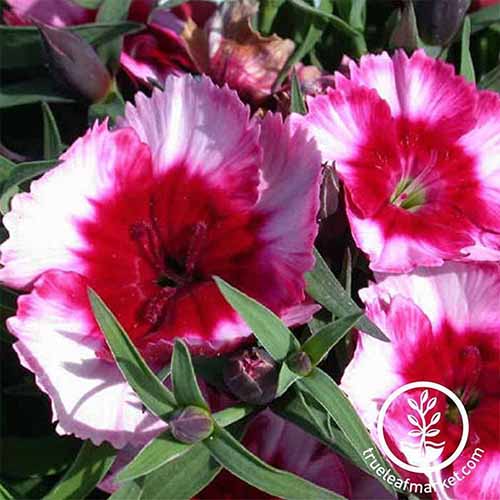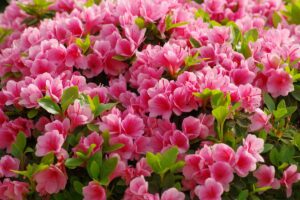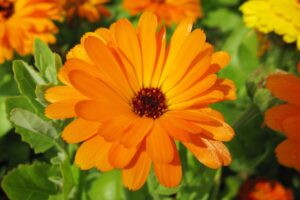Dianthus chinensis
A long-time favorite, China pink dianthus is beloved for its adorable fringed flowers in deeply saturated and patterned colors with a heavenly, spicy-sweet fragrance.
Delightful throughout the garden, the flat-faced flowers beguile in colors and combinations of burgundy, crimson, maroon, mauve, salmon, scarlet, pink, and white, with a soft, lightly rounded fringe.
Highly attractive to pollinators like bees and butterflies but resistant to deer, the pretty pinwheel flowers are borne on slender stems with attractive blue-green, elliptical foliage.
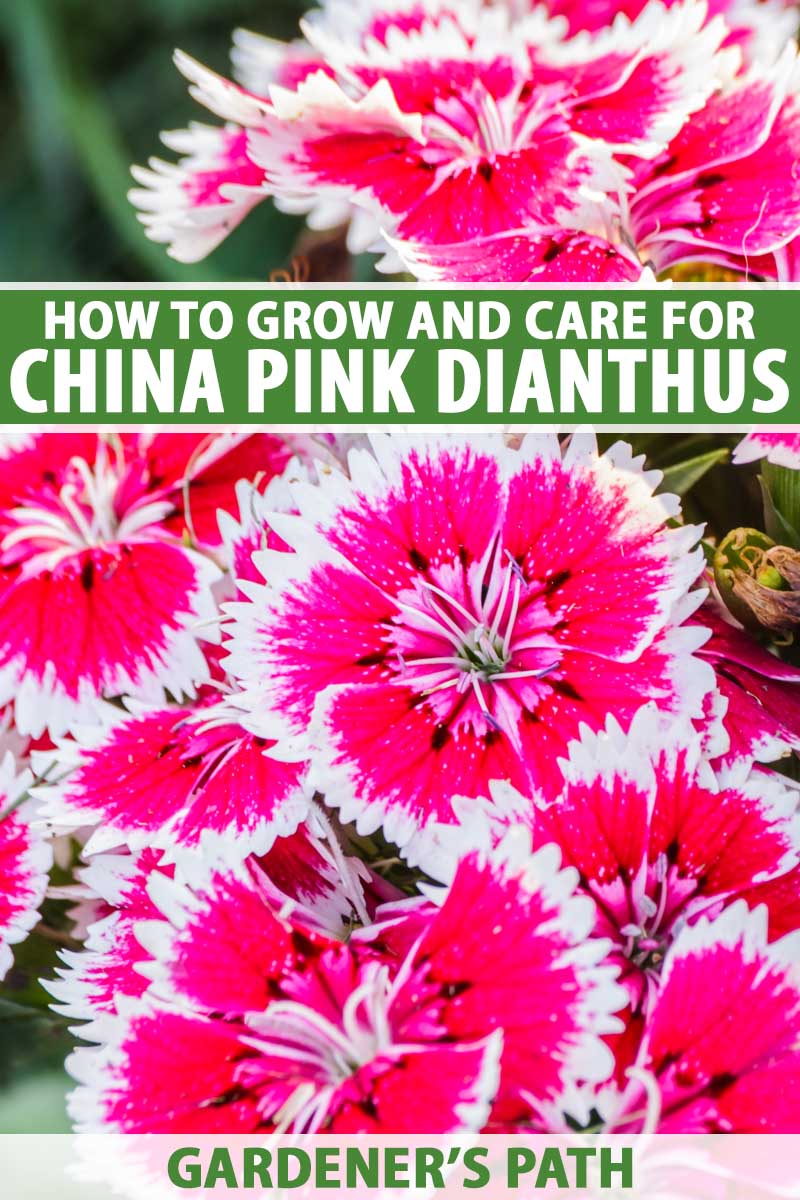
We link to vendors to help you find relevant products. If you buy from one of our links, we may earn a commission.
Grown as an annual, biennial, or short-lived perennial, this species is enchanting when mass planted in borders, containers, edging, or rockeries, and throughout butterfly, cottage, and courtyard gardens.
And China pinks are a classic in the cutting garden, with abundant, long-stemmed flower clusters and an extended vase life.
They also have a long growing season. Flowering from late spring with a lighter rebloom in the summer months, they make the greatest impact where they can be admired often, like beside garden benches, flanking entrances, along pathways, and in patio pots or window boxes.
To reap their high returns, let’s dig into the details on how to grow and care for China pink dianthus!
Here’s what we’ll cover:
What You’ll Learn
What Are China Pinks?
China pink dianthus, Dianthus chinensis, is yet another impressive member of the carnation family, Caryophyllaceae.

Also known as Japanese, Indian, and rainbow pinks or French mignonette, they feature a sweet fragrance of cloves and delicately fringed single, semi-double, or double flowers, with slightly rounded or curled tips.
The one- to three-inch, flat-faced flowers are vibrantly colored in the red palette, plus white, and many have intricate, bicolor patterns with contrasting borders and eyes or dramatic dark rings.
Plants typically form clumps or mounds of narrow, gray-green foliage with finely branched stems producing clusters of 10 to 15 flowers growing up to 30 inches tall.
However, most of today’s commercial cultivars are compact and bushier, reaching a mature height and spread of six to 15 inches.
Hardy in USDA Zones 5 to 9, they’re grown as annuals, biennials, or short-lived perennials with a life span of two to three years.
They enjoy cooler temperatures and flourish in late spring, then rebloom in the summer months after shearing. These plants can struggle in high heat and humidity, and appreciate afternoon shade for relief in hot climates.
Cultivation and History
D. chinensis is a species native to east Asia including regions of China, Korea, Mongolia, and Russia.
An herbaceous biennial or perennial, it enjoys a wide range of habitats such as sandy or rocky forest margins, grasslands, rocky slopes, and areas beside streams.
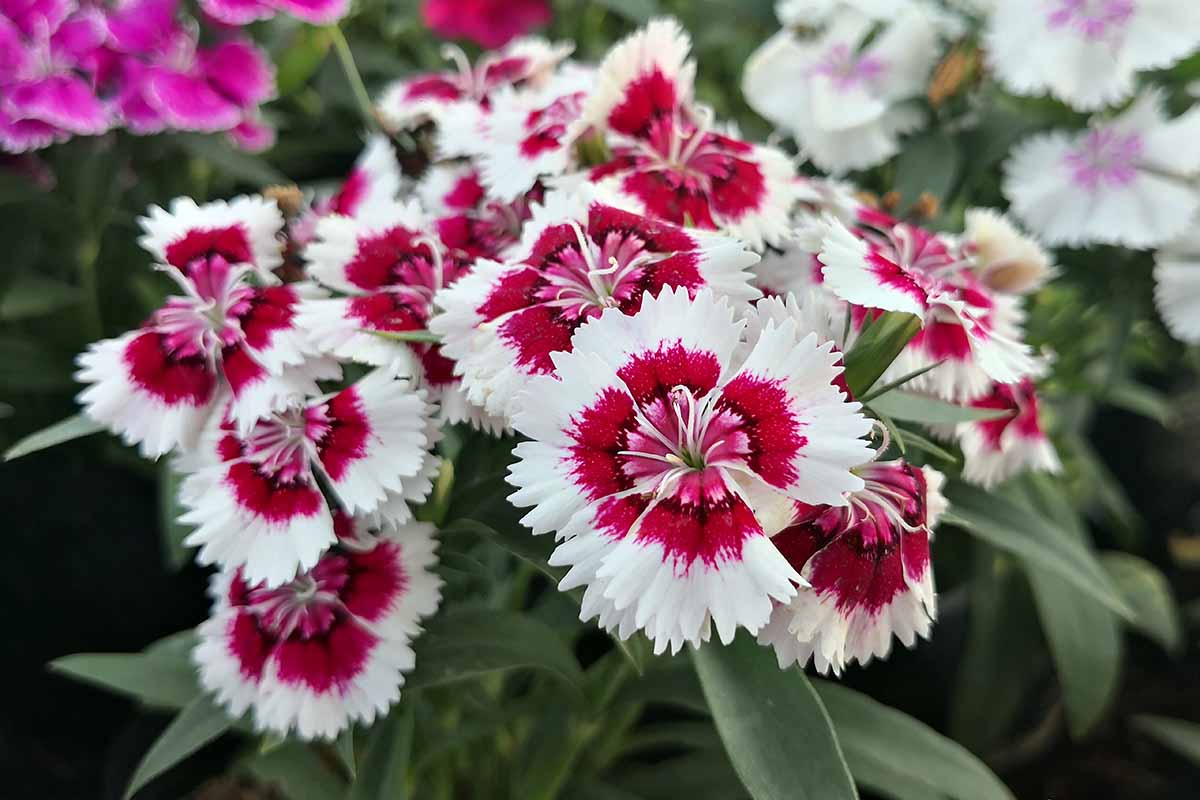
In their native Asia, they’ve long been cultivated for their ornamental value and use in traditional Chinese medicine – although it should be noted that D. chinensis plants contain low levels of triterpenoid saponins and are mildly toxic to humans, cats, and dogs.
Named by the Greek philosopher Theophrastus, it’s thought that the Romans were responsible for spreading dianthus plants throughout Europe, and they’ve been cultivated in North America since the early 18th century.
Classified as a short-lived perennial, they rarely live longer than two years and are typically treated as annuals or biennials due to their brief life cycle.
Propagation
D. chinensis can be propagated by seed or stem cuttings.
Start seeds indoors eight to 10 weeks before planting out, or sow outdoors as soon as the soil can be worked.
You can find propagation details in our guide on how to grow and care for dianthus flowers.
How to Grow
China pinks enjoy humus-rich and well-draining soil with a slightly gritty texture and a pH of 6.0 to 7.5.
They thrive in the cool temperatures of late spring and perform best in areas with cool summers, underperforming in regions with high heat and humidity.

In regions with mild summer temperatures, plant in full sun. In areas with hot summer sun and high temperatures, provide light or dappled afternoon shade. And in areas with mild winters, such as in Zones 9 or 10, they can be grown as winter annuals.
Enrich planting sites by digging in two to three inches of well-rotted compost or aged manure to a depth of 12 inches.
Free-flowing drainage is crucial to prevent crown rot.
To improve drainage, add in a shovelful of grit such as landscape sand or pea gravel before planting. Also, cultivating in mounds raised three to six inches is an easy way to improve drainage.
When planting, keep the crown even with or just slightly above the soil level to prevent rot. The crown is located at the plant’s base, where the downward-growing roots and upward-growing stems meet.
D. chinensis prefers slightly moist soil and requires regular water during the hot months, about one inch per week. You can check how much precipitation your garden is receiving with a rain gauge.
This species is somewhat drought-resistant when established as a biennial or short-lived perennial, but as an annual, care should be taken to prevent the roots from drying out.
In regions with hot summers, a two-inch layer of gravel mulch helps to retain moisture and keep roots cool.
Plant out after all danger of frost has passed and provide ample air circulation, spacing plants six inches apart.
D. chinensis tends to flower all at once in late spring. Shearing spent flowers promotes a lighter rebloom throughout the summer.
Growing Tips
- Plant in organically rich, well-draining soil.
- Provide one inch of water per week in the absence of rain.
- Mulch with gravel in hot locations.
Pruning and Maintenance
For those growing as annuals, remove plants in the fall after they die back from a heavy frost, or before winter arrives in frost-free zones.
Provide a two- to four-inch layer of dry mulch to biennials and perennials for winter protection, then remove the mulch in early spring.
During the growing season, apply an all-purpose fertilizer every four to six weeks, such as 10-10-10 or 10-20-10 (NPK).
After the first flush of flowers have finished, shear plants back by one-third. This is a quick and easy way to deadhead and the mounds grow back full and thick, developing new buds for reblooming in summer.
Cultivars to Select
Breeders have produced many popular D. chinensis series such as Carpet™, Charms, Ideal Select™, Super Parfait™, and Telstar™.
Here are a few of today’s favorite series and cultivars.
Baby Doll Mix
An outstanding heirloom variety, ‘Baby Doll’ Mix gives a vibrant and varied display with fantastic contrasting eyes, patterns, and rings in bright shades of burgundy, cherry, mauve, pink, and white.
The single, fringed flowers measure one to two inches and have a sweetly spicy fragrance. Plants form compact mounds with deep green, lancet-shaped foliage that reaches a mature height of 10 to 15 inches.
A classic for beds, borders, containers, and rockeries or butterfly, cottage, courtyard, and cutting gardens, this variety is hardy in Zones 3 to 9.
Seeds are available by the packet or in bulk at Eden Brothers.
Super Parfait Raspberry
Super Parfait™ ‘Raspberry’ is highly floriferous, and produces large and elegant bicolored blooms.
The two- to three-inch frilly flowers have rosy pink petals and soft-edged eyes of intense raspberry red that bleeds into the petals and along the edges.
The compact, dwarf plants have long, narrow, bluish-green leaves and grow only six to eight inches tall.
With a tidy, uniform habit, they’re striking when mass planted in beds, borders, and edging or in patio pots and window boxes. This variety is hardy in Zones 5 to 11.
Seed packets are available in two sizes at True Leaf Market.
You can also find seeds for Super Parfait™ ‘Red Peppermint’ which features white petals with candy cane eyes at True Leaf Market.
Diana Series Mix
A beautiful blend of fragrant, colorful flowers, the Diana Series Mix produces compact plants loaded with large, three-inch blooms in fantastic shades of crimson, rose, red-centered white, scarlet, scarlet picotee, and white.
This dwarf cultivar grows to a height of only eight inches, but delivers a big, bold impact, flowering from late spring to the end of summer.
The mounding, heat-tolerant plants have a draping habit that looks spectacular dripping from containers, hanging baskets, patio planters, and window boxes as well as in the rock garden. Plants are hardy in Zones 5 to 9.
Seeds are available at True Leaf Market.
Black and White
A truly unique cultivar, ‘Black and White’ has large, two- to three-inch fully double blooms with patterned, deep burgundy petals so dark they appear black, with white backsides and frilly white edges.

Among the most fragrant of China pinks, the dense plants reach a height of 14 inches with dark blue-green foliage and a beautiful array of stacked flowers that bloom from early summer until frost.
This cultivar is hardy in Zones 4 to 8.
Seeds are available in packets of 150 at Amazon.
Managing Pests and Disease
The occasional appearance of common pests like aphids and spider mites can be terminated with a strong spray of water from a garden hose. For more persistent infestations, apply a nontoxic pesticidal soap or neem oil.
Due to their preference for cooler temperatures, China pinks are often grown in partial shade, making them more susceptible to visits from creeping gastropods. If these pests become a problem, read our guide on how to protect your garden from slugs and snails.
D. chinensis can also develop Fusarium crown rot or rust when planted in poorly draining soil.
Ensure plants are located in well-draining soil and spaced for adequate air circulation. Also, maintain a regular watering schedule in hot weather to prevent stress, which leaves plants weakened and open to attack.
Best Uses
China pinks can be used in a variety of settings and garden schemes.
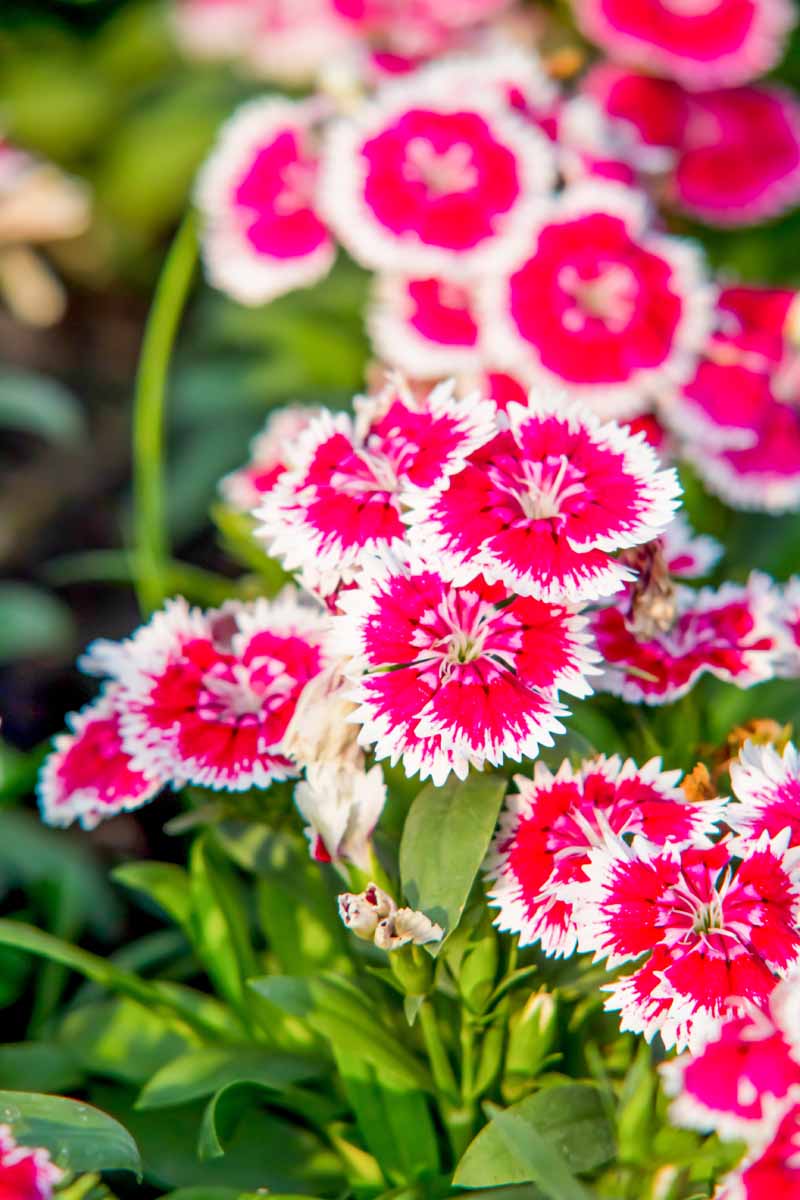
They make a gorgeous impact when planted en masse in beds, borders, and edging tracts, and their compact size makes them suitable for containers as well, including hanging baskets, patio pots, and window boxes.
And they make a pretty, fragrant addition to Asian, butterfly, cottage, cutting, gravel, and rock gardens, or tucked into pockets in rock walls and flanking paving stones.
For floral arrangements, cut flowers when the buds are halfway open.
Quick Reference Growing Guide
| Plant Type: | Short-lived flowering perennial | Flower / Foliage Color: | Burgundy, crimson, mauve, maroon, pink, salmon, scarlet, white, patterned bicolors/gray-green |
| Native to: | China, Korea, Mongolia, and Russia | Tolerance: | Deer, light shade |
| Hardiness (USDA Zone): | 5-9 | Maintenance: | Moderate |
| Season: | Late spring and summer | Soil Type: | Humus-rich and slightly rocky |
| Exposure: | Full to part sun | Soil pH: | 6.0-7.5 |
| Spacing: | 6 inches | Soil Drainage: | Well-draining |
| Planting Depth: | Shallow, crown even with or barely above the soil line (transplants) | Attracts: | Bees, butterflies |
| Height: | 6-30 inches | Uses: | Beds, borders, containers, edging; Asian, butterfly, cottage, courtyard, cutting, and rock gardens |
| Spread: | 6-12 inches | Order | Caryophyllales |
| Time to Maturity: | 120 days | Family: | Caryophyllaceae |
| Water Needs: | Moderate | Genus: | Dianthus |
| Common Pests and Diseases: | Aphids, spider mites, slugs, snails; crown rot, rust | Species: | Chinensis |
A Garden Delight
With fantastic patterned colors, an intense fragrance, and a long growing season, China pinks make a delightful addition to any garden setting.
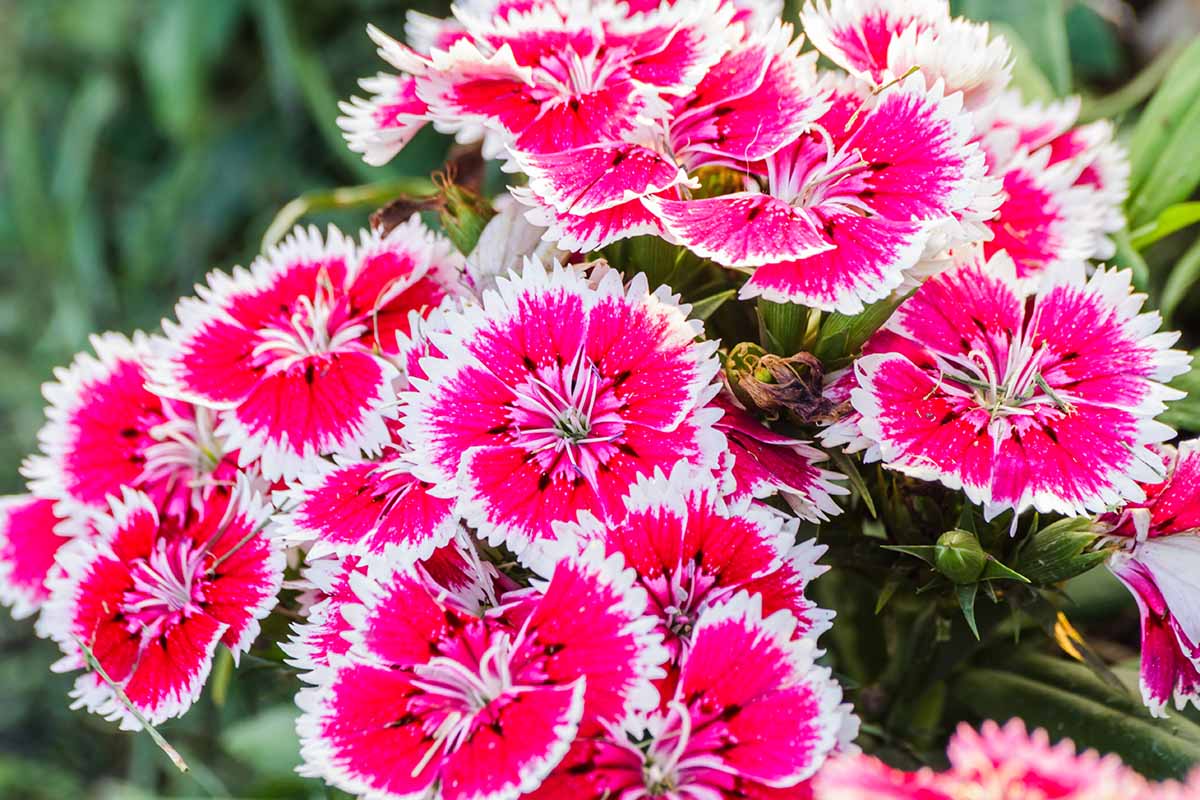
Provide them with regular water in dry spells, well-draining soil, and afternoon shade in hot temperatures to enjoy their perfumed beauty.
Remember to plant plenty for the cutting garden – you’ll want a steady supply for indoor floral arrangements as well!
If you folks have a China pink favorite, be sure to tell us in the comment section below.
And for more ideas about easy-to-grow, dianthus flowers, check out these growing guides next:

